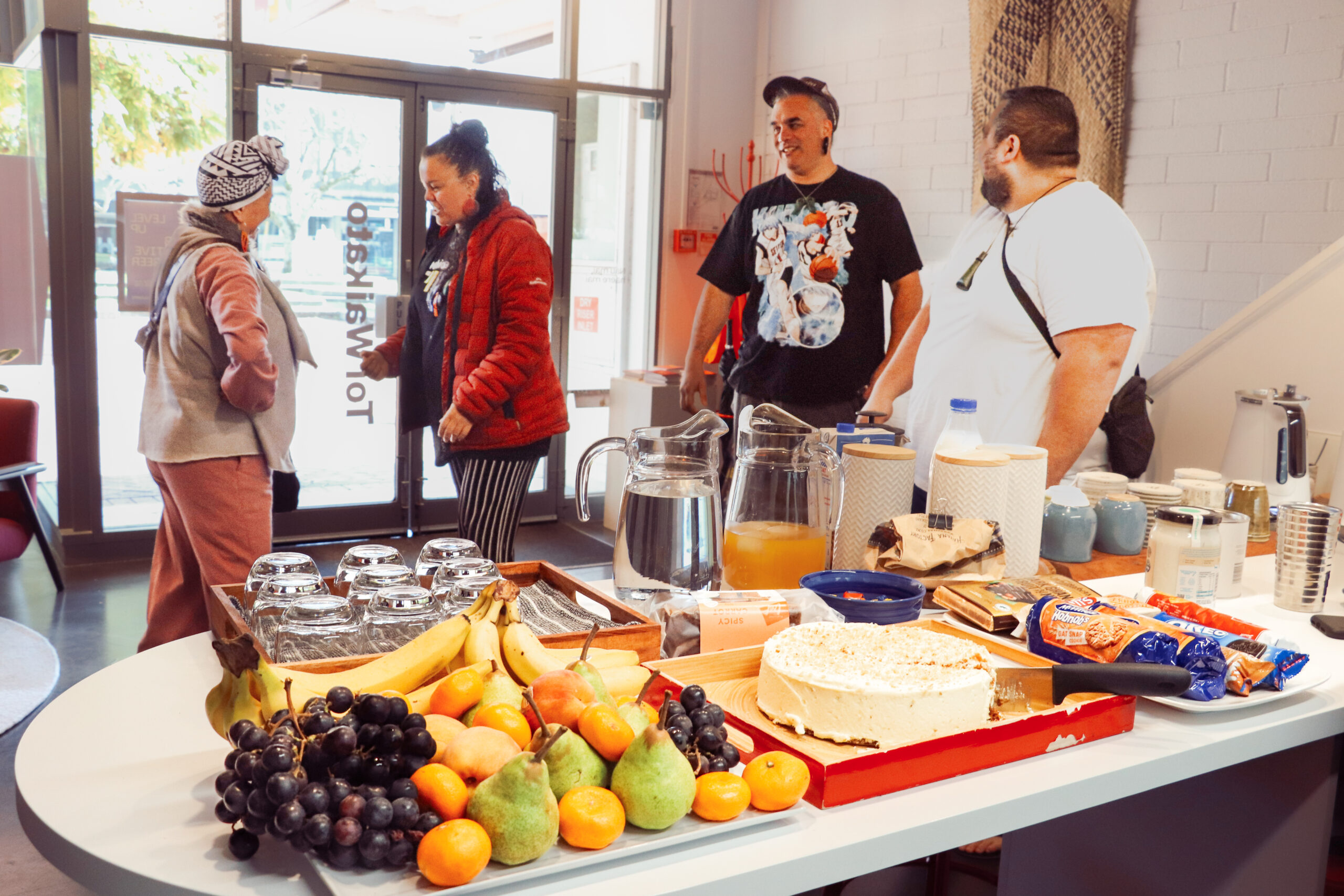Artists, connection and community - an observation of Whiria Te Tāngata


The sound of warm chatter was only broken with sparks of laughter and aroha as Whiria te Tāngata artists, mentors, and a selection of Creative Waikato team met for their regular wananga to connect and share experiences. As this pilot initiative moves into the final stages of delivery, these wānanga remain important connection points for this community of artists to share their learnings and celebrate their creativity and community impact.
Greeting the Whiria te Tāngata crew on their arrival was an array of delicious kai, which was magnetic, pulling everyone into the heart of the space where the hugs and refreshments that were served were plentiful. After greetings, stories began to pour out over the cups of coffee, sharing experiences, challenges and impacts their individual creative activities were having on the communities they connected to. It was a celebration of the hard mahi being delivered to make a meaningful impact for all the people who participate. The artists shared their experiences, and in return, they received celebration, support and the gift of advice from mentors who have years of experience, reassuring them and providing guidance to help soothe them, so fresh on their journey as community artists-in-residence with a programme that is new and unexplored in Aotearoa New Zealand.
Eventually, centring the energy in the space is the Whiria te Tāngata Project Lead, Leafā Wilson, began as usual with the Creative Waikato karakia then whakawhanaungatanga. Going around the space, inspirational humans shared who they are, opened the door to their creative practice, and made connections to their place in the programme; phenomenal people who understand the communities they are serving, and articulated where they could maximise local talent in those communities. It was clear that their bespoke community delivery through the conduit of creative activity, was resulting in human-connection and accessible creativity for all involved.
The room felt resplendent with mutual admiration, and for a moment, there was a hush of quiet as everyone contemplated and absorbed the sharing that had occurred. Breaking this quiet moment was the fabulous Benny Marama, a local Kirikiriroa creative working with young emerging Pasifika playwrights, helping them to tell their stories through theatre. As he stepped up to the front of the room to share his experience with a burst of energy and laughs, he brought joy to the space through his animated sharing of his experience in theatre as a Pasifika artist – sharing his story of working with his creative brother on stage, as well as facing the challenges and the stigma of being Pasifika in the performance space. This all gave a deeper context to his passion and understanding for the need of his programme going through the Whiria te Tāngata programme, IĒNA PASIFIKA.
Working on his community programme brought to light deeper meanings for himself as an artist. For him, it further highlighted a missing experience for the Waikato Pasifika youth community he works with.

“It has been great sort of confirming not just where I should be but where I want to be. It has made me more conscious of the stories I want to tell. It has made me want to have these kids explore different kinds of arts experiences. Like I keep saying to them, we are more than. We are incredible musicians, we are incredible dancers, we are incredible orators, and we are incredible storytellers. For me, especially here in the Waikato, here in Kirikiriroa, that storytelling side doesn’t get explored as much as it should.”
Throughout the rest of the hui there was the sharing and deeper introduction of the supporting mentors. The mentoring part of the programme acknowledges the importance of the tuakana-teina relationship, with experienced artists finding connection through guiding, supporting, educating and cheering on the community creative activity of the Whiria Te Tāngata artists. They work to support the growth, development and strengthening of their projects and creative lives.
These mentors are renowned in their arts ecosystem, come from a range of backgrounds and a wealth of experience, and have also been part of a number of hugely influential projects. From Paddy Free, one of New Zealand’s best-known electronic musicians, calling in from the road in Croatia to visual artist Regan Balzer sharing a recent project – the mesmerisingly meaningful and beautiful ‘Samoa Asks’, an artwork that was produced for Mana Moana Project in 2022. The stories that flowed from all mentors showed the depth of care, connection, knowledge and talent.
The experience of the mentors and the work that they shared was rich, and their stories alone impacted each artist in the room. It appeared to inspire them, to encourage them to push further into the deeper meaning behind their journeys as artists in residence serving their communities. The conversation encouraged the exploration of the deeper meanings of creative work, as well as understanding how to enable as much goodness and positive impact from community engaged creative practice as possible.
Leaving the hui, the feeling of hope washes over. Programmes like Whiria Te Tāngata are deeply impactful for community. Accessible creativity is a core contributor to positive wellbeing outcomes. It is exciting to know that in our Waikato region, there is a real difference being made through different forms of creative activity, through speaking to people in unique ways, and through working towards collective wellbeing with the people who understand their communities and work to address needs and challenges on a deep level.
Speaking of the progress these artists are making, Leafā has said, “Knowing that the Waikato communities are truly benefiting from the highly skilled musical, literary, visual and performing arts knowledge of our 10 Whiria Te Tāngata artists is satisfying. The WTT artists gain just as much from working with people of all knowledge levels. They’re learning that wellbeing is multiplied by sharing what they love doing and creating small creative communities who are empowered by this exchange of kotahitanga and wananga.”